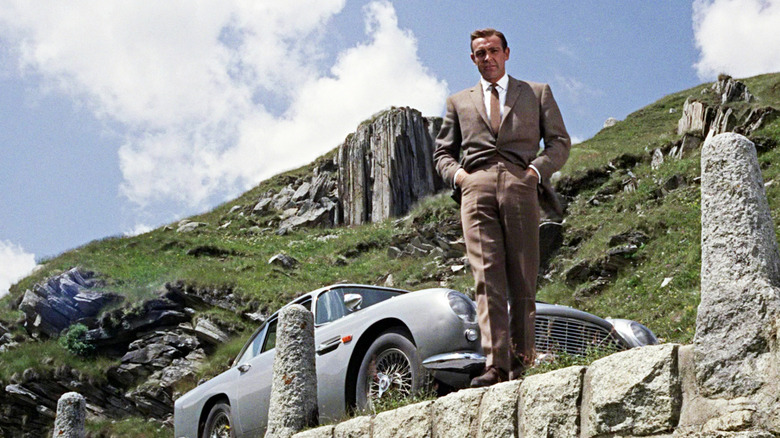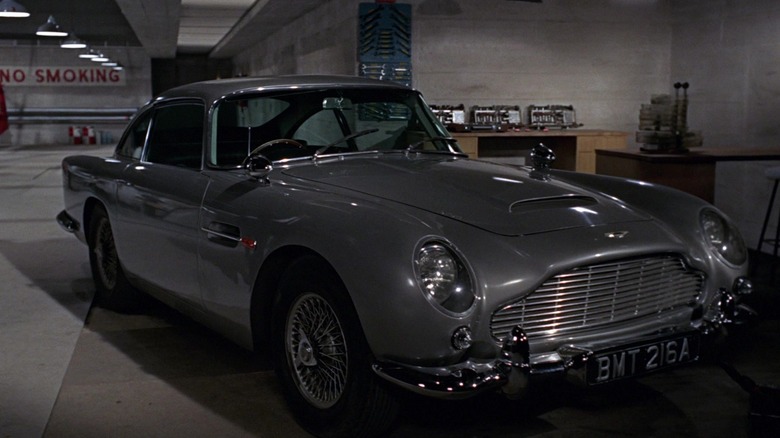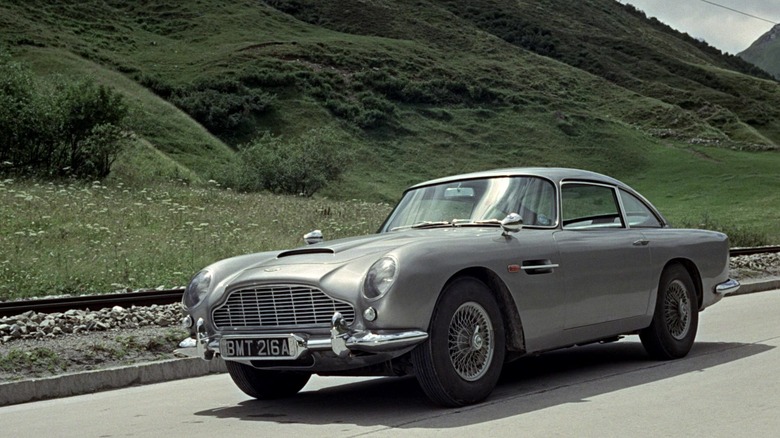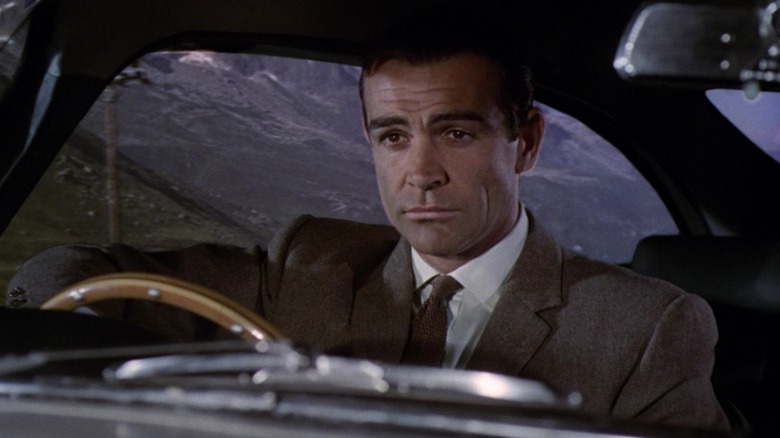James Bond's Signature Aston Martin Almost Never Existed
One of the many James Bond franchise staples introduced in 1964's "Goldfinger" was 007's Aston Martin DB5. Throughout his 60-year cinematic run, Bond has had the pleasure of driving some of the finest vehicles in the world, but none have become as synonymous with England's greatest spy as the DB5. Which is why, to this day, Aston Martin's 1963 luxury grand tourer remains the best James Bond car.
Prior to "Goldfinger," there had been two Bond movies: 1962's "Dr. No" and 1963's "From Russia With Love." In the former, 007 was seen riding in a Sunbeam Alpine, and in the latter a Bentley Mark IV — an odd choice considering the car had been around for a good 30 years prior to Sean Connery's Bond making use of it. And in Ian Fleming's first Bond novel, "Casino Royale," the MI6 agent drove a 1930 Blower Bentley, a racing version of the Bentley 4½ Litre. With "Goldfinger," however, the producers felt it was time for a change.
So, the DB5 debuted with the third entry in the Bond saga. The same model has since shown up in a total of eight movies in the franchise, reappearing in "Thunderball," "GoldenEye," "Tomorrow Never Dies," "Casino Royale," "Skyfall," "Spectre," and "No Time to Die." The car was also supposed to be featured in "The World Is Not Enough," but its scenes were cut prior to the 1999 film's release. All of which is to say that the DB5 has truly become almost as famous as James Bond himself. With that in mind, it's strange to think that the DB5 almost didn't make it into "Goldfinger" in the first place.
Convincing Aston Martin
There's a somewhat meta moment in "Goldfinger" — still regarded as one of the best Bond movies ever — where Sean Connery's Bond meets with Desmond Llewelyn's Q and asks "Where's my Bentley?" to which Q replies, "It's had its day, I'm afraid." That was quite literally true in terms of Bentley being Bond's car of choice, as Q would swiftly introduce a new vehicle: the 1963 Aston Martin DB5, complete with a range of "modifications." These included bullet-proof windows, revolving number plates, a GPS tracking system, and of course the ejector seat. Add to that an array of "defense mechanisms," from machine guns to smoke screens, and the DB5 of "Goldfinger" was unlike anything Aston Martin had ever manufactured.
Which might be why the company was hesitant at first. In Matthew Field and Ajay Chowdhury's 2015 book, "Some Kind of Hero: The Remarkable Story of the James Bond Films," the authors note how screenwriter Richard Maibaum originally planned for Bond to drive a Bentley in the film. But, as Production Designer Ken Adam recalled, there was some debate about whether that was the right choice:
"There were E-Type Jaguars, Aston Martins, Italian Ferraris, and Alfa Romeos. We decided the Aston Martin [DB5], which was by far the most expensive British sports car, would be the right prop for Bond."
Unfortunately, Aston Martin wasn't all that thrilled when producer Harry Saltzman first contacted them, reportedly showing "no interest" in loaning their cars to the production. As General Manager Steve Heggie is quoted as saying, "We had many such requests in those days from film producers and in general it cost Aston Martin more than it was worth." It was only due to the persistence of Saltzman that the company ultimately acquiesced and provided the "Goldfinger" crew with two DB5s.
Things (sort of) worked out for the best
As per The Telegraph, Aston Martin initially provided one DB5, which was "based on a prototype DB4 but virtually identical to a DB5 and ingeniously fitted out by [Special Effects wizard John] Stears and his team of craftsmen at Pinewood Studios." But it seems Harry Saltzman was unnerved at the prospect of racing what he called a "$45,000 little bag of tricks" around, and managed to get a second, standard DB5 delivered to the production for the high-speed scenes.
Of course, the DB5s provided by Aston Martin arrived sans the gadgets, which meant that the production team had to build all the modifications themselves. As Ken Adam recalled in "Some Kind of Hero," many of the additions were inspired directly by his own experiences, with the front bumper being added as a way to make up for Adam's own Jaguar E-Type being "continuously damaged by other people." The revolving plates, meanwhile, were originally conceived of as a way for Adam to get around the numerous parking tickets he was being issued in London.
Despite Aston Martin's initial trepidation, everything worked out pretty well for them, with the DB5 almost instantly becoming what is widely regarded as one of, if not the most famous car in the history of cinema. Still, the company was perhaps right to be hesitant initially, as it transpired that some of the crew members on "Goldfinger" would routinely borrow the cars on lunch breaks. Thankfully, both models made it through the production, although as The Telegraph reported, one of the originals used in the film was stolen from its owner's private aircraft hangar at Boca Raton Airport in June 1997, before supposedly being spotted as part of a private collection in the Middle East in 2022.
An enduring legacy
"Goldfinger" is often cited as a providing a blueprint for all the Bond films that followed, establishing longstanding Bond traditions and tropes that are still being used in the series to this day. Matthew Field and Ajay Chowdhury noted in "Some Kind of Hero" how the Bond movies have, since "Goldfinger," also "become instrumental in partnering brands with films and Aston Martin has become synonymous with 007."
There's arguably no stronger commercial partnership in the history of Bond movies than the franchise's ongoing relationship with Aston Martin. That all basically stemmed from "Goldfinger," which turned the DB5 into almost as big an icon as James Bond himself. As Chief Creative Officer at the car company, Marek Reichman, said in a 2021 video, "By the time we got to 'Thunderball,' DB5 was going out of production because we oversold. We could only make 11 cars a week, and there was a demand for 50."
That love for the DB5 hasn't wavered since. The car featured in the first big chase in 2021's "No Time To Die," and in 2018, some 54 years after the car made its on-screen debut, Aston Martin announced it would be creating 25 new editions of the iconic Silver Birch DB5 complete with an array of gadgets to match the original version from "Goldfinger." Which is not only a testament to the car's enduring legacy as an iconic on-screen vehicle, but a reminder that when James Bond asks you for a favor, you should always say yes.



